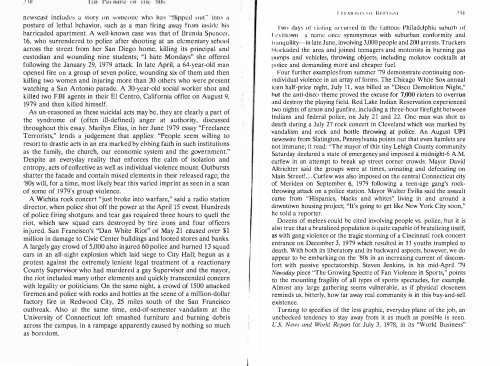CONTENTS - ouroboros ponderosa
CONTENTS - ouroboros ponderosa
CONTENTS - ouroboros ponderosa
Create successful ePaper yourself
Turn your PDF publications into a flip-book with our unique Google optimized e-Paper software.
.' III<br />
newscast incluues a stury on someone who has "nipped oUI" inlo "<br />
posturc of lethal hehavior, such as a man firing away fmm inside his<br />
barricaded apartment. A well-known case was that of Brenda Spencer.<br />
16, who surrenden:d to police after shooting at an elementary school<br />
across the strcet from her San Diego horne, killing its principal and<br />
custodian and wounding nine students; "I hate Mondays" she offered<br />
following the January 29, 1979 attack. In latc April, a 64-year-old man<br />
opened fire on a group of seven police, wounding six of them and then<br />
killing two women and injuring more than 30 others who were present<br />
watching a San Antonio parade. A 30-year-old social worker shot and<br />
killed two FBI agents in their EI Centro, California officc on August 9,<br />
1979 and then killed himself.<br />
As un-reasoned as these suicidal acts may be, they are clearly a part of<br />
thc syndrome of (often ill-defined) anger at authority, discussed<br />
throughout this essay. Marilyn Elias, in her June 1979 essay "Freelance<br />
Terrorists," lends a judgement that applies: "People seem willing to<br />
resort to drastic acts in an era marked by ebbing faith in such institutiuns<br />
as the family, the church, our economic system and the government."<br />
Despite an evcryday reality that enforces the calm of isolation and<br />
cntropy, acts of collective as well as individual violence mount. Outbursts<br />
shatter the facade and contain mixed elements in their released rage; the<br />
'80s will, for a time, most likely bear this varied imprint as seen in a scan<br />
of some of 1979's group violence.<br />
A Wichita rock concert "just broke into warfare," said a radio station<br />
director, when police shut off the power at the April 15 event. Hundreds<br />
of police firing shotguns and tear gas required three hours to quell the<br />
riot, which saw squad cars destroyed by tire irons and four officers<br />
injured. San Francisco's "Dan White Riot" of May 21 caused over $1<br />
million in damage to Civic Center buildings and looted stores and banks.<br />
A largely gay crowd of 5,000 also injured 60 police and burned 13 squad<br />
cars in an all-night explosion which laid siege to City Hall; begun as a<br />
protest against the extremely lenient legal treatment of a reactionary<br />
County Supervisor who had murdered a gay Supervisor and the mayor,<br />
the riot included many other elements and quickly transcended concern<br />
with legality or politicians. On the same night, a crowd of 1500 attacked<br />
firemen and police with rocks and bottles at the scene of a million-dollar<br />
factory fire in Redwood City, 25 miles south of the San Francisco<br />
outbreak. Also at the same time, end-of-semester vandalism at the<br />
University of Connecticut left smashed furniture and burning dehris<br />
across the campus, in a rampage apparently caused by nothing so much<br />
as boredom.<br />
1 · 11· II· N rs {II , t.:.I' H lA I _<br />
Two days of rilltillg tllTlJITeU in the famous Philadelphia suhurh or<br />
I.,.,vilt()wn a nam ()nc synonymous with suburban confurmity and<br />
1 r:lIlquility-in late June, involving 3,000 people and 200 arrests. Truckers<br />
hloekaded the area and joined teenagers and motorists in burning gas<br />
pllmps and vchicles, throwing obj ects, including molutov cocktails at<br />
police and demanding more and cheaper fuel.<br />
Four furthcr examples from summcr '79 demonstrate continuing non<br />
individual violence in an array of forms. The Chicago White Sox annual<br />
teen half-price night, July 11, was billed as "Disco Demolition Night,"<br />
hut the anti-disco theme proved the excuse for 7,000 rioters to overrun<br />
and destroy the playing field. Red Lake Indian Reservation experienced<br />
two nights of arson and gunfire, including a three-hour firefight between<br />
Indians and federal police, On July 21 and 22. Onc man was shot to<br />
death during a July 27 rock conccrt in Cleveland which was marked by<br />
vandalism and rock and bottle throwing at police. An August UPI<br />
newswire from Slatington, Pennsylvania points out that even hamlets are<br />
not immune; it read: "The mayor of this tiny Lehigh County community<br />
Saturday declared a state of emergency and imposed a midnight-6 A.M.<br />
curfew in an attempt to break up street corner crowds. Mayor David<br />
Altrichter said the groups were at times, urinating and defecating on<br />
Main Street! .... Curfew was also imposed on the central Connecticut city<br />
of Meriden on September 6, 1979 following a teen-age gang's rock<br />
throwing attack on a police station. Mayor Walter Evilia said the assault<br />
carne from "Hispanics, blacks and whites" living in and around a<br />
downtown housing project; "It's going to get like New York City soon,"<br />
he told a reporter.<br />
Dozens of melees could bc cited involving people vs. police, but it is<br />
also true that a brutalized populatiun is quite capable of brutalizing itself,<br />
as with gang violence or the tragic storming of a Cincinnati rock concert<br />
entrance on December 3, 1979 which resulted in 11 youths trampled to<br />
death. With both its liberatory and its backward aspects, however, we do<br />
appear to be embarking on the '80s in an increasing current of discomfort<br />
with passive spectatorship. Steven Jenkins, in his mid-April '79<br />
NelVsday piece "The Growing Spectre of Fan Violence in Sports," points<br />
to the mounting fragility of all types of sports spectacles, for example.<br />
Almost any large gathering seems vulnerable, as if physical closeness<br />
reminds us, bitterly, how far away real community is in this buy-and-sell<br />
existence.<br />
Turning to specifics of the less graphic, everyday plane of the job, an<br />
unchecked tendency to stay away from it as much as possible is seen.<br />
u.s. News and World Report for July 3, 1978, in its "World Business"






